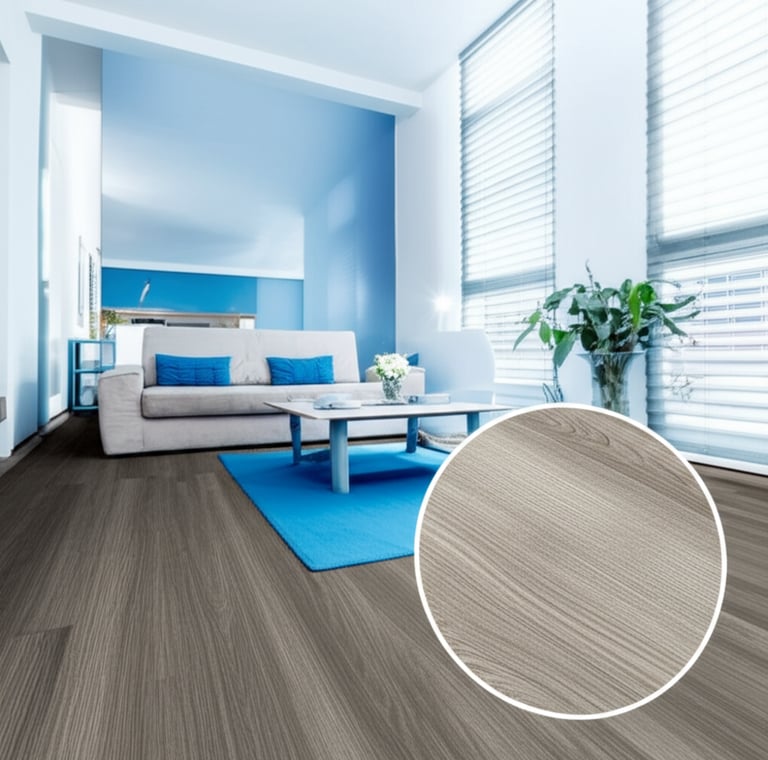Best Vinyl Plank Flooring for Every Room
Discover the best vinyl plank flooring for every room in your house. Durable, stylish, aesthetic, waterproof and luxury options for kitchens, bathrooms, and more.
DIY & HOME IMPROVEMENTS
Sophia Reed
8/2/20256 min read


The Complete Guide to Choosing Vinyl Plank Flooring for Every Room
When I first started writing about home improvement three decades ago, vinyl flooring was often considered the budget option that homeowners settled for rather than chose. How times have changed! Today's vinyl plank flooring has completely revolutionized the industry, offering stunning alternatives that can fool even the most discerning eye.
After spending years touring manufacturing facilities, interviewing homeowners, and personally testing countless products, I can confidently say that modern vinyl plank flooring deserves serious consideration for any home renovation project. Let me walk you through everything you need to know to make the right choice for your space.
What Makes Today's Vinyl Plank Flooring Special?
The vinyl flooring of today bears little resemblance to what your grandmother might have had in her kitchen. We're talking about sophisticated manufacturing processes that create incredibly realistic textures and patterns. I've watched visitors run their hands over vinyl planks, convinced they were touching real hardwood.
The secret lies in advanced printing technology and multi-layer construction. These aren't the thin, obviously fake sheets of decades past. Modern vinyl planks have substance, weight, and visual depth that mimics natural materials beautifully.
The Three Main Types You'll Encounter
Through my years of research and home visits, I've found that understanding the three main categories helps homeowners make better decisions:
1.Luxury Vinyl Tile (LVT)
Represents the premium end of the spectrum. When clients ask me about the "Cadillac" of vinyl options, this is what I point them toward. The wear layers are thick, the designs are sophisticated, and the durability rivals traditional hardwood in many applications.
2.Rigid Core Vinyl
It has become my go-to recommendation for most homeowners. The multi-layer construction includes a composite core that provides incredible stability. I've seen these products perform beautifully in challenging environments where traditional hardwood would warp or buckle.
3.Flexible Vinyl
It still has its place, particularly for DIY enthusiasts working with tight budgets. While it may not have all the bells and whistles of premium options, quality flexible vinyl can deliver years of reliable service when properly installed.
Why Homeowners Are Making the Switch
Over the years, I've interviewed hundreds of homeowners about their flooring choices. The reasons for choosing vinyl plank consistently center around practical benefits that matter in real-world living.
Durability consistently tops the list. Families with active children, pet owners, and anyone dealing with high-traffic areas appreciate how well vinyl holds up. I've revisited homes five years after installation and found floors that still look remarkably fresh.
The water resistance factor cannot be overstated. Traditional hardwood's Achilles heel has always been moisture, but quality vinyl planks shrug off spills, humidity, and even minor flooding. This opens up possibilities for spaces that were previously off-limits to wood-look flooring.
Installation ease has democratized flooring renovation. I've watched weekend warriors transform entire rooms using click-together systems that require no special tools or expertise. The sense of accomplishment homeowners feel when completing these projects themselves is genuinely rewarding to witness.
How Modern Manufacturing Creates Stunning Results
The technological advances I've observed in vinyl manufacturing over recent years are remarkable. UV-cured finishes have largely replaced traditional wear layers in premium products, providing superior protection against scratches and stains.
Pattern repeat technology has solved one of vinyl's historical weaknesses – the obvious repetition that made floors look artificial. Modern printing can create hundreds of unique plank patterns, ensuring your floor looks as random and natural as real wood.
High-definition imaging captures subtleties that would have been impossible to reproduce even a decade ago. Wood grain texture, stone variations, and color nuances all contribute to the authentic appearance that surprises visitors.
Real-World Performance Testing
Having followed industry testing standards for years, I appreciate the rigorous evaluation methods used by organizations like the Good Housekeeping Institute. Their testing protocols simulate years of real-world use in controlled environments.
Durability testing involves over twenty hours of continuous wear simulation, equivalent to years of normal foot traffic. Products like Shaw Parallax HD Plus consistently excel in these evaluations, maintaining their appearance despite aggressive testing.
Water resistance testing reveals significant differences between products. Rigid core options like Mohawk SolidTech Plus demonstrate impressive performance, with joints that remain watertight even under challenging conditions.
Stain resistance varies considerably between brands and product lines. ReNature by Coreluxe has consistently impressed in laboratory testing, resisting common household stains that would permanently damage other flooring types.
Matching Flooring to Your Lifestyle
Through countless home consultations, I've learned that the "best" flooring depends entirely on how you live. Let me share some insights about different room applications.
Kitchens and Bathrooms: Where Water Resistance Rules
Moisture-prone areas demand waterproof construction, not just water resistance. The distinction matters more than many homeowners realize. True waterproof products like Mohawk SolidTech Plus can handle standing water without compromise.
Design variety in waterproof options has expanded dramatically. Gone are the days when choosing waterproof meant sacrificing style. Today's products offer everything from rustic barn wood appearances to sophisticated stone looks.
Installation considerations become critical in wet areas. Proper subfloor preparation and attention to transitions can make the difference between a successful installation and future problems.
Living Areas: Balancing Beauty and Practicality
Family rooms and bedrooms present different challenges. Noise reduction becomes important, especially in multi-story homes. Products with attached underlayment, like Shaw Parallax HD Plus, significantly reduce footfall noise.
Visual authenticity matters more in prominent living spaces. High-definition printing and realistic texturing help vinyl planks blend seamlessly with other design elements. I've seen installations where guests needed convincing they weren't looking at real hardwood.
Comfort underfoot shouldn't be overlooked. Premium products with cushioned backing provide a more pleasant walking experience, particularly important in areas where you might walk barefoot.
Basements and High-Traffic Zones: Durability First
Below-grade installations present unique challenges. Concrete subfloors, potential moisture issues, and temperature fluctuations all factor into product selection. Flexible options like Armstrong American Personality Pro often perform well in these challenging environments.
Heavy traffic areas need robust wear layers and scratch resistance. I've watched families with large dogs put floors through tests that would destroy lesser products. Quality matters when you're dealing with daily abuse.
Easy maintenance becomes crucial in high-traffic areas. Embossed surfaces that hide dirt can be appealing, but they may require more effort to keep clean. Smooth surfaces with good stain resistance often prove more practical long-term.
Installation: DIY or Professional?
The installation question comes up in nearly every consultation. My honest assessment depends on several factors that homeowners should carefully consider.
DIY-friendly products like SMARTCORE make weekend projects feasible for motivated homeowners. Click-together systems eliminate the need for adhesives and complex tools. I've seen impressive results from first-time installers who took their time and followed instructions carefully.
However, professional installation averages around $2,500 for typical homes, with square-foot costs ranging from $2 to $10 depending on complexity. This investment often makes sense for expensive products or challenging layouts.
Room size affects the decision significantly. Single rooms of 200 square feet might cost $400 to $2,000 for professional installation, making DIY more attractive. Whole-house projects often benefit from professional efficiency and expertise.
Budget Considerations That Matter
Pricing transparency helps homeowners make informed decisions. Products like Lifeproof offer excellent value at under $4 per square foot, making larger projects more affordable. However, the cheapest option isn't always the best value.
Hidden costs can surprise unwary buyers. Underlayment, transition strips, and installation supplies add to the base product cost. Professional installation includes these elements, while DIY projects require separate budgeting.
Long-term value deserves consideration. Premium products with superior wear layers and warranties often prove more economical over time than frequent replacements of budget options.
Standout Products I've Tested
After years of product evaluation, certain names consistently rise to the top of my recommendations.
ReNature by Coreluxe impresses with stain resistance that handles real-world challenges. The wood grain patterns convince even skeptical visitors, while the UV-cured finish provides long-term durability.
Lifeproof delivers exceptional value without major compromises. The scratch-resistant surface and waterproof construction handle busy households well, though the embossed texture requires slightly more maintenance effort.
Hartco Everguard targets families with active lifestyles. The padded underlayment provides comfort, while the rigid core construction resists damage from pets, children, and furniture movement.
Making Your Final Decision
Choosing flooring involves balancing aesthetics, performance, and budget. Visit showrooms to see and feel actual samples. Lighting conditions affect appearance significantly, so view products under various conditions.
Consider your household's specific needs. Pet owners prioritize different features than empty nesters. Active families have different requirements than adult households.
Don't rush the decision. Quality vinyl plank flooring should serve you well for many years. Take time to research, compare options, and choose confidently.
Frequently Asked Questions
1.What makes vinyl plank flooring worth considering over traditional options?
Modern vinyl combines the beauty of natural materials with practical advantages like water resistance and easier maintenance. After three decades of observing flooring performance, I've seen vinyl evolve into a genuinely compelling choice that performs well in real-world conditions.
2.How do I choose the right vinyl for my kitchen renovation?
Kitchens demand waterproof construction and stain resistance. Look for products with thick wear layers and realistic visuals that complement your design. Mohawk SolidTech Plus consistently performs well in kitchen applications based on both testing and homeowner feedback.
3.Is DIY installation realistic for average homeowners?
Many homeowners successfully install click-together systems like SMARTCORE. The key is honest assessment of your skills and available time. Simple, rectangular rooms work well for first-time installers, while complex layouts might warrant professional help.
4.What should I budget for a vinyl plank flooring project?
Professional installation averages $2,500 for typical homes, with materials and labor ranging from $2-10 per square foot. DIY projects can significantly reduce costs but require time and effort investment. Always factor in additional supplies and tools when budgeting.
5.How do I maintain vinyl plank flooring for maximum lifespan?
Regular sweeping and occasional mopping with mild cleaners handle routine care. Address spills promptly, avoid harsh chemicals, and use furniture pads to prevent scratches. Proper maintenance keeps vinyl floors looking fresh for many years.
